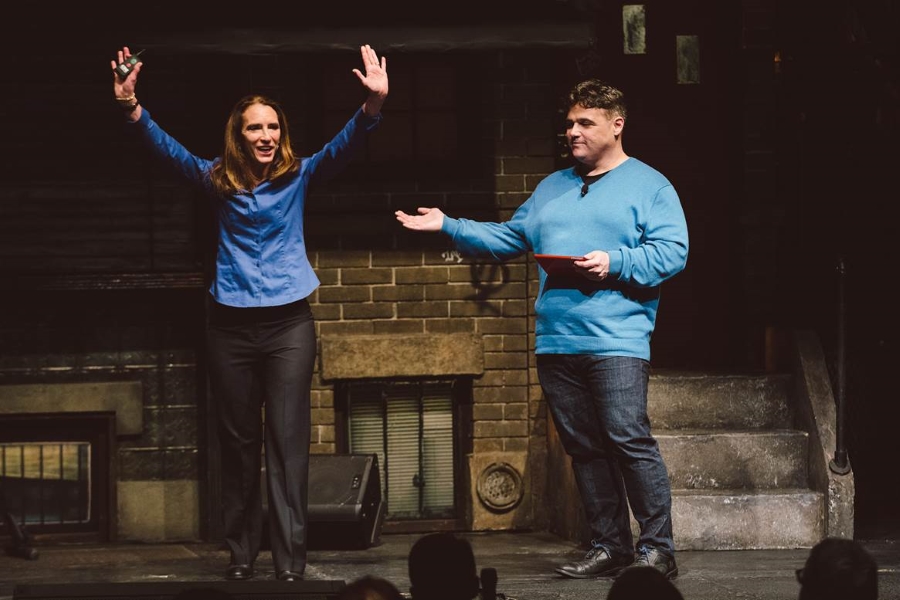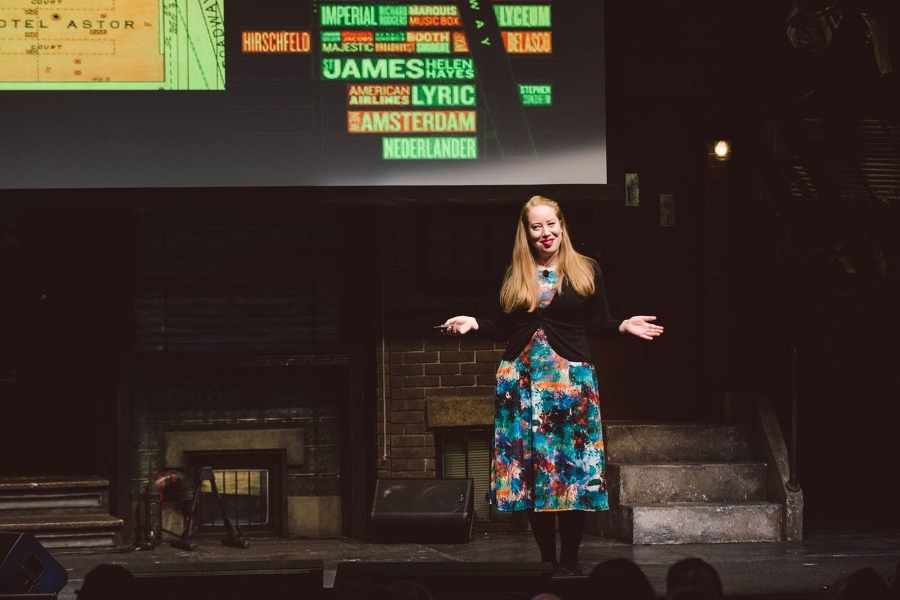NEW YORK CITY: The Broadway ecosystem spans further than just a few Manhattan blocks and involves more communities of people than those who work within the theatre industry. And this year’s TEDxBroadway brought them all together.
Speakers at the 5th annual event, which took place on the set of Avenue Q at New World Stages on Feb. 22, included scientists, inventors, lawyers, screenwriters, visual artists, and dancers—but the one thing they all share is a passion for live performance and an interest in how to better the Broadway community.
“This day is definitely about the amazing presentations and performances,” said TEDxBroadway co-organizer Jim McCarthy, CEO of entertainment deals company Goldstar, as he welcomed attendees to the event. “But in large part, it is about the connections and conversations that will happen during and after this event.”
The conference kicked off with Charlie Rosen and the Callbacks performing reimagined renditions of songs from classic musicals. The six-piece band stayed for the whole day, providing entertainment between sessions.
One of the morning speakers was Jennifer Ashley Tepper, director of programming at Feinstein’s/54 Below. Tepper took the room on a journey to the past in a presentation about the intersection of real estate and Broadway. Tepper stressed the need to invest in historic theatres, reclaim abandoned Broadway houses, and strive to create spaces that will last for generations.
“This is an amazing time to be around Broadway—producers are battling for this limited number of houses like never before,” she said. “There are all these shows with the money to get to Broadway, and not enough spaces to hold them.”

Accessibility was a focus of the second session. Katie Sweeney, a mother of a child with autism and a theatre lover, spoke about her challenging quest to share her passion for Broadway musicals with her son. On one of their first trips to the theatre together, she and her son were asked to leave because his vocal responses to the show were bothering the backstage crew. “I will tell you, that was, to date, profoundly the most isolating moment on this autism journey that I’m on,” she said. With the help of programs such as Theatre Development Funds’ Autism Theatre Initiative, which hosts relaxed performances for people with autism and their families, Sweeney is on another journey: to help make theatre accessible to all.
DJ Kurs, the artistic director of Deaf West Theatre in Los Angeles, presented his speech in American Sign Language. He spoke about the complicated but rewarding process of fusing the speaking and signing worlds, and the hearing and Deaf worlds, when creating a show at his company. The company’s revival of Spring Awakening recently bowed on Broadway, and in addition to featuring Deaf performers, the cast included an actor in a wheelchair—the first to appear on Broadway.
“When Ali Stroker wheeled herself into that audition room on a hot summer afternoon in Los Angeles of 2014, I admit—my mind went there,” he said. “How would this work? Was the venue that we selected going to be accessible for Ali? That’s how a producer thinks, but that’s also human nature. We saw Ali’s talent and we knew that Spring Awakening would be a better show with her in it. So we forged ahead into the unknown, and we offered her the role.”
Magic came up several times in the talks. Circus artist and comedian Marcus Monroe brought some literal magic when he showed off his juggling skills onstage—and kept the crowd on the edge of their seats with a trio of spiraling knives. Later, a group of magicians from Monday Night Magic played card tricks and entertained attendees during an afternoon coffee break.
But the speakers weren’t just theatre professionals and performers. Scientist and engineer Erin Lavik spoke about how minoring in playwriting in college inspired her to ultimately pursue her dream of being a scientist. She is currently engineering polymers to protect and repair the nervous system from trauma. “Theatre is dreaming realized,” she said. “I want to see us all realize the possibility for what we all can do, and what we all can make.”
Miral Kotb’s career in dance and theatre came to a halt when she found a tumor on her right hip. During remission, she began working at Bloomberg pursuing her other passion as a software engineer. She learned that her computer-savvy coworkers were hesitant to attend theatre and live performances, which inspired her to create iLuminate—a wearable wireless lighting system for dancers. “I wanted to bring theatre to more people, and one way I knew how to do it was to bring technology into it—because then you open the doors to a wider audience,” she said. Kotb spoke about the seamless integration of theatre and technology in iLuminate and how computer scientists are collaborating with choreographers and dancers to create live performances.
Many people—not just artists—have to overcome a fear of failure to succeed, and the speakers emphasized the importance of saying yes. On the other hand, saying yes to too many things can also be overwhelming for creative professionals, as Hannah Kohl noted in her talk. She has performed hundreds of odd jobs, and her problem of saying yes to everything led to her current job as a paper cutter. She creates designs for theatre production marketing and sets. “I always look for the open door, and I always say yes,” she said. Kohl worked between talks to create a paper cutting inspired by the TEDxBroadway speakers and conversations she had with attendees throughout the day.
Kelly Leonard took the notion of saying “yes” a step further by saying “yes and.” As the president and CEO of Kelly Leonard Productions and creative advisor to Second City, Leonard spoke about how setbacks can be a launching pad for epic failures to become successes. Leonard spoke about receiving negative comments about shows at the comedy theatre and receiving hate mail.
“If you work at a satiric comedy theatre, you frame it and put it on the wall,” he laughed. “The point is, to improvise and to innovate, you have to be able to fail, and you have to embrace your failure. You’re going to go up on your lines and you’re going to forget what comes next. In our case at the Second City, it has meant that years and years of making it up as we go.”
I spent the day in “the Loft,” as part of the young professionals program sponsored by the Shubert Foundation and the Nederlander Organization. Each year, TEDxBroadway selects 36 young professionals working in different capacities that relate to the Broadway community. In addition to attending TEDxBroadway, the young professionals—made up of technology gurus, special education teachers, lawyers, sports management students, and social media mavens—have been meeting to brainstorm ideas of how the theatre community worldwide can be improved.
“They have ideas; we should spend time with them and start nurturing them,” said Damian Bazadona, co-organizer of the conference and cofounder of marketing agency Situation Interactive. “The reality is, looking forward, they are going to be solving and evolving the issues we have on the stage.”
The conference set solutions in motion. The speakers embraced the industry’s past, took stock of current issues, and provided attendees with the inspiration needed to take the Broadway community into a future of inclusivity and technology. Collaboration, teamwork, perseverance—and maybe a little bit of magic—can get us there.


